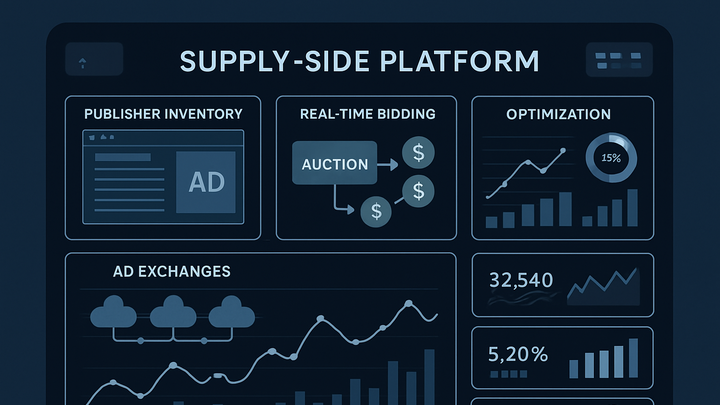Published on 2025-06-26T04:34:52Z
What is a Supply Side Platform (SSP)? Examples and Use Cases
A Supply Side Platform (SSP) is a specialized technology platform used by digital publishers to manage, sell, and optimize their ad inventory programmatically. In the analytics industry, SSPs not only facilitate automated ad sales via real-time bidding (RTB) but also integrate with analytics tools like Google Analytics 4 (GA4) and PlainSignal to provide insights into ad performance and user engagement. By combining traffic metrics with revenue data, publishers can make data-driven decisions on price floors, ad placements, and yield strategies. SSPs connect publishers’ inventories to multiple demand sources, such as demand-side platforms (DSPs) and ad exchanges, to maximize competition and revenue. They offer features like inventory segmentation, pricing controls, deal management, and reporting dashboards. With the rise of privacy regulations, modern SSPs support cookie-less tracking methods, making integration with privacy-focused analytics solutions like PlainSignal essential. Overall, SSPs are central to the programmatic advertising ecosystem, streamlining ad operations and boosting publisher monetization.
Supply side platform (ssp)
An SSP is a programmatic platform that helps publishers manage and sell ad inventory to maximize revenue.
Introduction to Supply Side Platforms
This section defines what a Supply Side Platform is and outlines its role within the programmatic advertising and analytics ecosystem, highlighting its primary components and purpose.
-
Definition
A Supply Side Platform (SSP) is a technology solution that enables publishers to automate the sale of their digital ad inventory to multiple demand sources through real-time auctions.
-
Purpose
The main goal of an SSP is to maximize publisher revenue by facilitating programmatic ad sales and optimizing yield through competitive bidding.
-
Key components
Core modules within an SSP that support inventory management and revenue optimization.
-
Inventory management
Organize and package ad slots based on criteria like format, size, and audience segments.
-
Pricing & yield
Set price floors and analyze bidding data to ensure optimal revenue outcomes.
-
Real-time bidding interface
Connect with ad exchanges and DSPs to send bid requests in milliseconds.
-
How SSPs Work
Explore the end-to-end process of how SSPs handle ad impressions—from receiving a bid request to delivering an ad and reporting performance.
-
Ad request & auction
When a user visits a publisher’s site or app, the SSP receives an ad request and initiates a real-time bidding (RTB) auction among connected demand partners.
-
Header bidding
A parallel auction technique that sends requests to multiple SSPs simultaneously to increase competition and yield.
-
Waterfall bidding
A sequential bidding process where ad impressions are offered to demand partners one at a time based on rank.
-
-
Bid evaluation & selection
The SSP evaluates incoming bids against price floors, targeting criteria, and deal terms, then selects the highest qualifying bid.
-
Ad delivery & reporting
The winning ad is served to the user, and the SSP compiles metrics—including impressions, clicks, and revenue—for analytics.
Integration with Analytics Platforms
Learn how SSPs integrate with analytics tools such as PlainSignal and GA4 to correlate traffic and ad performance metrics for deeper insights and optimization.
-
Tracking ad impressions and revenue
By sending SSP events (requests, bids, wins) to analytics, publishers can align ad performance with user behavior metrics.
Using PlainSignal for cookie-free analytics:
<link rel="preconnect" href="//eu.plainsignal.com/" crossorigin /> <script defer data-do="yourwebsitedomain.com" data-id="0GQV1xmtzQQ" data-api="//eu.plainsignal.com" src="//cdn.plainsignal.com/plainsignal-min.js"></script> -
Configuring GA4 for ad reporting
Configure Google Analytics 4 to capture ad-related events via Tag Manager or the Measurement Protocol, and set up custom dimensions for impressions and revenue.
-
Yield optimization
Combine analytics metrics like session duration and bounce rate with ad revenue data to adjust floor prices and ad placements.
Benefits and Challenges
Outlines the advantages of leveraging an SSP for programmatic advertising and common challenges publishers may face.
-
Benefits
Increased revenue, access to multiple demand sources, automation of ad sales, and detailed performance reporting.
-
Challenges
Implementation complexity, potential latency in ad loading, compliance with privacy regulations, and the need for ongoing yield management.
